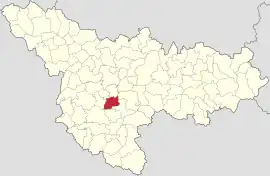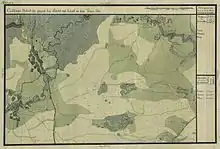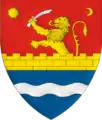Pădureni | |
|---|---|
.jpg.webp) The Orthodox church in Pădureni | |
 Location in Timiș County | |
 Pădureni Location in Romania | |
| Coordinates: 45°36′N 21°13′E / 45.600°N 21.217°E | |
| Country | Romania |
| County | Timiș |
| Government | |
| • Mayor (2020–2024) | Dorin Ignuța[1] (PNL) |
| Area | 53.3 km2 (20.6 sq mi) |
| Population (2021-12-01)[3] | 2,052 |
| • Density | 38/km2 (100/sq mi) |
| Time zone | EET/EEST (UTC+2/+3) |
| Postal code | 307236 |
| Vehicle reg. | TM |
| Website | primaria-padureni |
Pădureni (until 1965 Lighed;[4] Hungarian: Temesliget; German: Paduren; Ukrainian: Гусарька; Turkish: Erdevik) is a commune in Timiș County, Romania. It is composed of a single village, Pădureni. It was part of Jebel commune before being split off in 2004.
Geography
Pădureni is located about 18 km (11 mi) south of Timișoara, at the angle formed by the "dead" Timiș and the "flowing" Timiș.[5] It borders Șag to the north, Liebling to the east, Jebel to the south and Parța to the northwest.
History

The first recorded mention of Pădureni dates from 1332, under the name of Legvid.[6] At the same time, there is a village called Mira (1310), now disappeared, which legend has it was destroyed in a Turkish raid.[7] In an Ottoman defter, around 1590, the name of Ligit is also mentioned. After this moment no other data are known until 1761, when it appears again mentioned with the name Lighed or Temeslighed and a number of 312 houses.[7]
University professor Remus Crețan claims that today's locality was formed towards the end of the Turkish era, "on account of the Romanian and Turkish elements from Timiș meadow".[8] According to historian Nicolae Ilieșiu, after the conquest of Banat by the Austrians, the locality was systematized by Count Mercy, from where until then the village was a "clog" on Trajan's Wall in the area called Iarc.[8] It has been mostly Romanian ever since; the Romanian majority was preserved even during the periods of intense colonization of Banat.
Demographics
Pădureni had a population of 1,938 inhabitants at the 2011 census, up 19% from the 2002 census. Most inhabitants are Romanians (93.09%), with a minority of Roma (1.14%). For 4.49% of the population, ethnicity is unknown.[9] By religion, most inhabitants are Orthodox (89.16%), with a minority of Pentecostals (1.86%). For 5.88% of the population, religious affiliation is unknown.[10]
| Census[11] | Ethnic composition | ||||
|---|---|---|---|---|---|
| Year | Population | Romanians | Hungarians | Germans | Roma |
| 1880 | 1,568 | 1,441 | 20 | 49 | – |
| 1890 | 1,668 | 1,538 | 32 | 66 | – |
| 1900 | 1,873 | 1,696 | 70 | 86 | – |
| 1910 | 1,822 | 1,611 | 62 | 66 | 73 |
| 1920 | 1,782 | 1,641 | 60 | 70 | – |
| 1930 | 1,698 | 1,574 | 29 | 13 | 70 |
| 1941 | 1,976 | 1,773 | 50 | 28 | – |
| 1956 | 1,641[lower-alpha 1] | – | – | – | – |
| 1966 | 2,235 | 2,070 | 46 | 16 | 96 |
| 1977 | 2,185 | 2,086 | 23 | 5 | 67 |
| 1992 | 1,566 | 1,479 | 15 | 8 | 60 |
| 2002 | 1,623 | 1,439 | 11 | 4 | 164 |
| 2011 | 1,938 | 1,804 | 17 | – | 22 |
Notes
- ↑ Including data on Pădurenii Mici's population
References
- ↑ "Results of the 2020 local elections". Central Electoral Bureau. Retrieved 16 June 2021.
- ↑ "Primăria Pădureni". Ghidul Primăriilor.
- ↑ "Populaţia rezidentă după grupa de vârstă, pe județe și municipii, orașe, comune, la 1 decembrie 2021" (XLS). National Institute of Statistics.
- ↑ "Decret nr. 799 din 17 decembrie 1964 privind schimbarea denumirii unor localități". Portal Legislativ.
- ↑ "Cadrul geografic". Primăria comunei Pădureni.
- ↑ Dalea, Dana Oana (2007). Contribuții la monografia comunei Pădureni. Timișoara: Brumar. p. 16. ISBN 978-973-602-305-7.
- 1 2 "Scurt istoric". Primăria comunei Pădureni.
- 1 2 Crețan, Remus (2006). Dicționar toponimic și geografico-istoric al localităților din județul Timiș. Timișoara: Editura Universității de Vest. p. 117. ISBN 973-7608-65-8.
- 1 2 "Tab8. Populația stabilă după etnie – județe, municipii, orașe, comune". Institutul Național de Statistică.
- 1 2 "Tab13. Populația stabilă după religie – județe, municipii, orașe, comune". Institutul Național de Statistică.
- ↑ Varga, E. Árpád. "Temes megye településeinek etnikai (anyanyelvi/nemzetiségi) adatai 1880-2002" (PDF).
